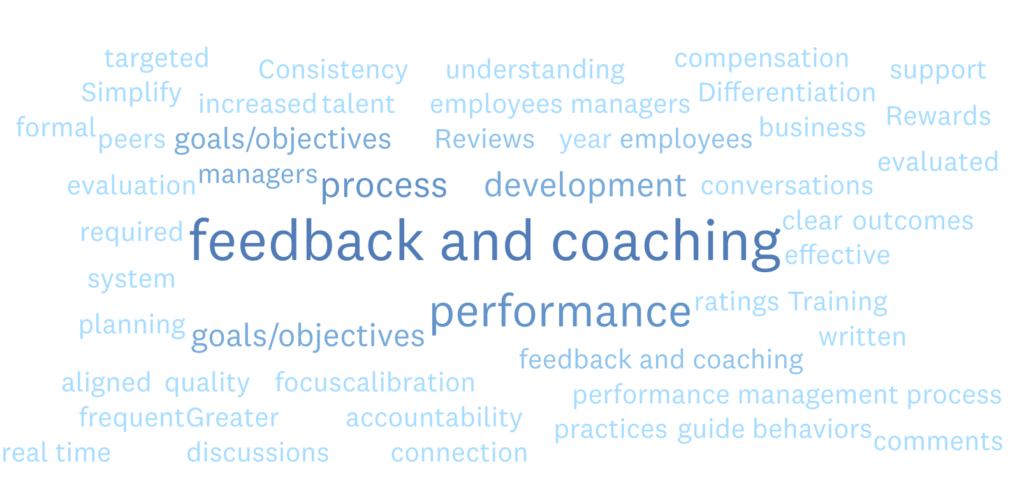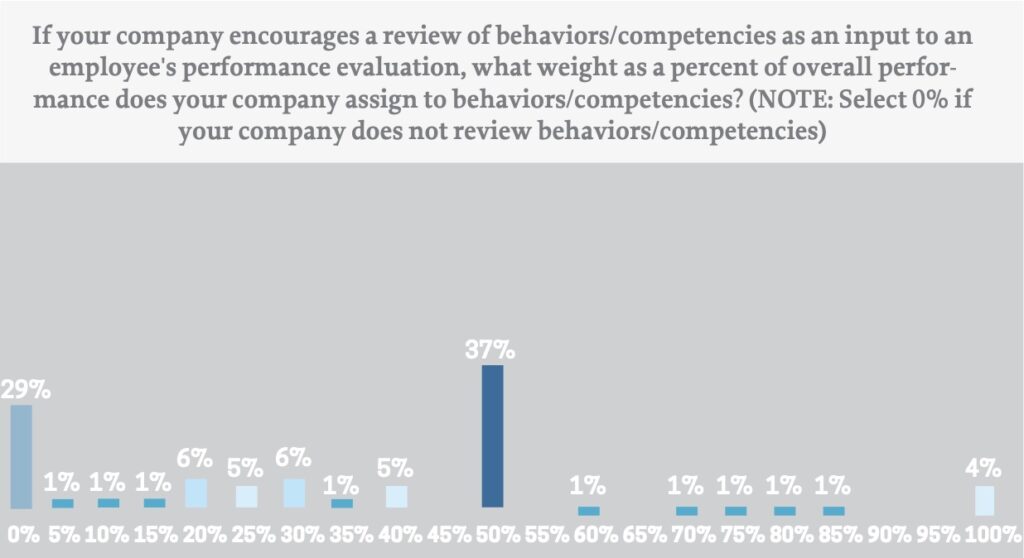Global Performance Management Report 2023
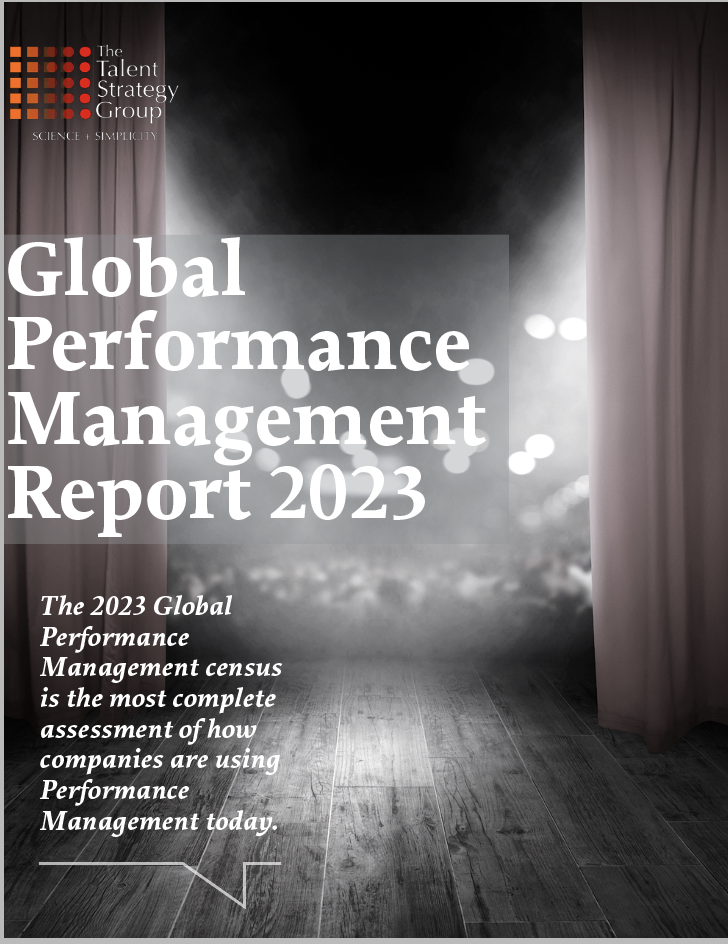
About This Report
The 2023 Global Performance Management Report provides specific insights to the practices companies are using (and not using) today in their performance management process. More than 300 companies worldwide participated with strong representation across small, medium and large organizations. All data was gathered in late 2022.
This report provides you with details on global practices of goal setting, coaching, reviewing, training, and technology related to performance management. We provide a summary of each area and commentary for each question.
While we present data that could be considered benchmark information, we strongly caution our readers from drawing conclusions about what is correct or incorrect based solely on these findings. There is clear science that can specifically inform you of the best answer to your design questions or at least send you in the right direction to find those answers. That science is a far better guide than what companies are or aren’t doing in this area.
As with any data gathering effort this survey could be subject to biases including selection bias, response bias and sampling bias. We are confident we have a representative sample of companies around the globe, but you should apply your own skeptical lens when you analyze the results.
We hope you find the results valuable, and we would be happy to support your company’s enhancement of their performance management process.
Best regards,
Marc Effron, President, Talent Strategy Group
Executive Summary
We find nearly all surveyed companies have performance management in place, and yet 80% of them have re-designed it in the past four years. This indicates either a dissatisfaction with the current approach and/or striving to implement something perceived to be novel and more effective.
Despite that near universal embrace of redesign, we find that traditional Performance Management practices remain dominant when we look at the processes for goal setting, coaching and reviewing.
Goal setting: Nearly every survey company has a goal setting process and the few that don’t are primarily smaller organizations. Goals are set once a year and at most companies goal changes are allowed but are rarely made. Goals remain the standard way to set objectives with OKRs or a combination of OKR and goals ranking a distant second.
The alignment of those goals is in question since only a third of companies have a logical and structured goal cascade. And that might be the reason why in the majority of companies goals are not set until three or more months into the performance management process in the majority of companies.
The good news in goal setting is that the recommended number of goals is just 3 to 4. The quality of those goals is unchecked however, since only one out of ten organizations has any quality check on the goals that are set.
Coaching/Feedback: Employees get about half of their company’s recommended number of coaching or feedback sessions. At only a minority of those companies is there any requirement to enter a confirmation in the system. Coaching and feedback remains a top down exercise with upward or peer feedback used at about one in three companies.
Reviewing: Formal performance reviews remain a staple of performance management, despite the noise about them over the past 10 years. Annual reviews represent the majority of what companies use with a significant minority of organizations having formal twice a year reviews.
While the most popular balance of performance and behaviors in reviews is 50% on each, that’s only found in 37% of companies. The average weighting of behaviors is 32%. The great battle over ratings or no ratings ended with a dud. Only 10% of companies in our survey don’t use ratings and they are largely smaller organizations. The most popular rating scale is a 5-point scale, with the 3-point scale a very distant second choice.
Only 17% of organizations force a distribution, but more than half engage in some form of ratings calibration.
Training: Perhaps companies’ efforts to redesign performance management would be better focused on training their leaders on how to execute their current practice. Not even 2 in 10 companies require leaders to be formally trained to set goals, transparently coach, or conduct reviews.
We hope you enjoy our 2023 Global Performance Management Report. We take pride in bringing you the most insightful, relevant and applicable insights on the HR topics that you care about the most.
Overall
1. IT’S A (NEAR) UNIVERSAL PROCESS
Finding: Performance management is a near universal process with 95% of companies having this in place. Of the 5% without one, more than half plan to implement it in their next year.
Observation: While we strongly support having a performance management process, it does not have an independent right to exist. Ask yourself, “What is the purpose of performance management in my organization”? The process can’t achieve its purpose if it doesn’t have one.
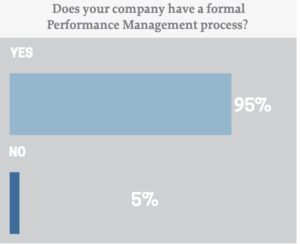
2. TWO PROCESSES: MANAGEMENT AND HOURLY
Finding: When the PM process doesn’t apply to every- one, those not included are front-line, hourly, unionized and those covered by a works council. Curiously, a few responses mentioned that senior leaders or executives did not follow the same process as others.
Observation: While the exclusion of unionized employees and those covered by works councils is understandable, front-line employees can use the same basic framework of goals, feedback, and reviews. When senior leaders use a different process, it creates an impression of exclusivity that undercuts sponsorship of the core process.
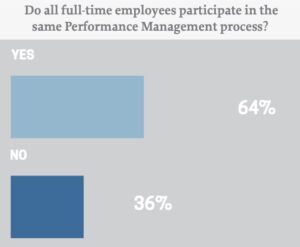
3. NOT PARTICULARLY EFFECTIVE (AT ANYTHING)
Finding: Not even 20% of companies rated their process as highly or very effective at providing high quality feedback and coaching, increasing individual performance, accurately reviewing performance or developing individuals. Just over 20% said that goal setting reached that standard.
Observation: These results suggest that performance management isn’t delivering effectively on any possible outcome, from increasing performance, guiding development or linking to compensation. We find that when PM doesn’t have a clear purpose, it’s designed to serve every possible goal (perform, develop, pay, engage) and ends up serving none.

4. LEADERS LACK THE CAPABILITY TO EXECUTE PM
Finding: Only 12% of leaders can provide high quality coaching and feedback. Just 23% can set challenging goals. The theme that emerges is that leaders’ lack of capability is fundamentally undercutting the ability of performance management to deliver higher performance.
Recommendation: Few companies engage in comprehensive, hands-on training of people leaders in goal setting and coaching. Without these capability-building investments, leaders will never grow their capabilities in the areas that elevate performance.
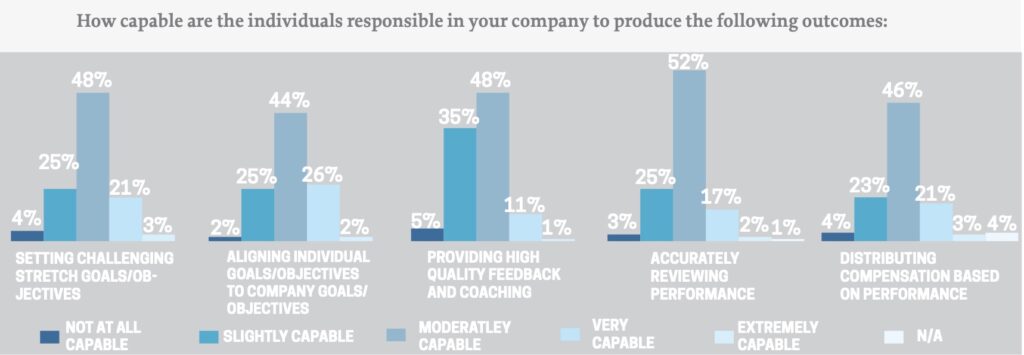
5. MAKING IT BETTER, OR JUST DIFFERENT?
Finding: 88% of companies have redesigned PM in the last 4 years and 50% in the last 2 years alone.
Recommendation: The implication is that there’s dissatisfaction with the results that the process is delivering. We find that clarifying the purpose (as mentioned earlier) and radically simplifying the process from goal setting to reviewing, quickly adds value and increases user satisfaction.
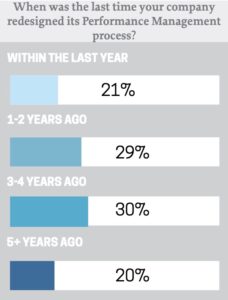
Goal Setting
6. STARTING THE PROCESS RIGHT
Finding: The overwhelming majority of companies have a formal process to set goals or objectives. Those few companies that do not are primarily smaller organizations (2,500 employees or fewer).
Recommendation: This is an essential first step but the earlier questions on process effectiveness and leader capability show that there’s some distance between the process step and effective execution of it.
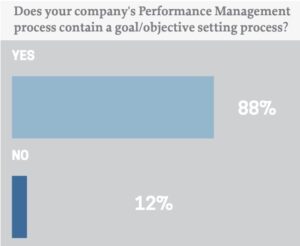
7. TRADITIONAL TIMING ON GOAL SETTING
Finding: Most companies set goals once a year. This annual process could suggest that goals are getting stale or dated as the year progresses. However, companies report that they stay agile in goal-setting as we show in a few pages.
Recommendation: We think annual goal setting is a fine process if there is a quarterly goal review to ensure that the goal itself and the metric are still appropriate. Importantly, we do not recommend reducing targets on goals, even if there is a difficult economic climate. The only legitimate reason to change a metric is if there has been a fundamental change in the marketplace (i.e. your largest customer went bankrupt) that would make the original goal unattainable.
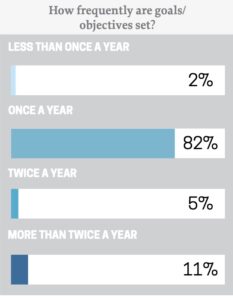
8. SOMEWHAT AGILE APPROACH TO GOALS
Finding: While a few organizations don’t allow goals to be changed, most allow changes but rarely see changes made.
Recommendation: We recommend quarterly conversations where goals are reviewed to ensure the goal and metric are still appropriate, and changed when not.
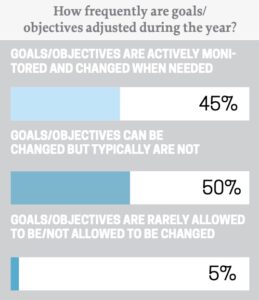
9. GOALS TYPICALLY MUST BE RECORDED
Finding: Nearly 80% of responding companies stated that goals need to be recorded in a technology platform. Of the 10% that do not require this, all but one are smaller companies.
Recommendation: We believe that it’s a misguided metric to track the percentage of goals recorded in a system. In our goal quality audits, we find that goals are poorly written at all levels. We suggest focusing effort on helping leaders improve their goals, not whether they are recorded in a system.
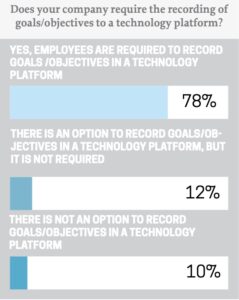
10. GOALS DOMINATE; A FEW COMPANIES USE OKRS
Finding: About 2/3 of responding companies use goals or objectives to structure what work will get done. Less than 10% use OKRs exclusively.
Recommendation: How goals are set is less relevant than the question, “Does every employee know the few big things they need to deliver to their organization this year/quarter and why?” That level of clarity and connection to value is what the process should be designed to deliver.
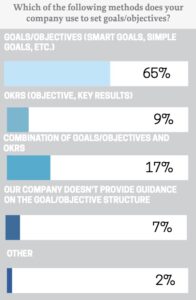
11. NO CASCADE MAKES ALIGNMENT CHALLENGING
Finding: Only 1/3 of companies have and execute a process to logically flow priorities through the organization. This finding is consistent across company size.
Recommendation: It’s possible that other mechanisms in companies help ensure that employee are delivering on the organization’s most important objective. We strongly recommend that companies create a tightly scheduled cascade that ensures goal alignment by the beginning of the performance period.
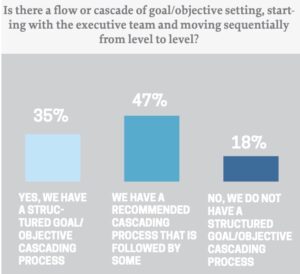
12. STANDARD OBJECTIVES SURPRISINGLY COMMON
Finding: About 2/3 of companies have a universal objective either every year or in some years.
Recommendation: We find that universal goals can accelerate the achievement of company-critical initiatives like Six Sigma, DE&I or engagement. It’s essential that the goal be specific (not “select a leadership goal”) and have enough weight in reviews to matter to the employee.
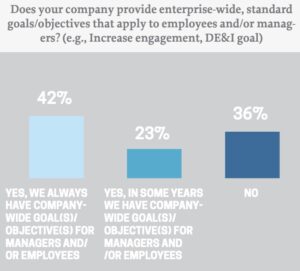
13. JUST A FEW GOALS, SAY MORE ORGANIZATIONS
Finding: 3 – 4 goals are requested to be set at the majority of organizations and the average number actually set is 4. Nearly every organization provides guidance for how many goals should be set.
Recommendation: Our experience is that many leaders have 8 or more goals, so we were pleasantly surprised by this finding. We recommend 3 – 4 goals that are the vital few, not one’s “day job,” difficult to achieve and aligned to the organization’s or function’s priorities.
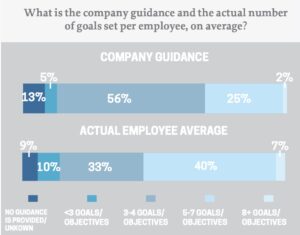
14. EMPLOYEES LEAD THE GOAL SETTING PROCESS
Finding: Employees set their own goals in just over 50% of companies, with managers setting them in about 40% of organizations. Not known is whether there is cascaded goal information given to employees before they set their goals.
Recommendation: We recommend that managers lead the goal setting process, but not set goals for their direct reports. “Lead the goal setting process” means that managers tell employees the few big goals they have set, and ask employees to align their goals to those where possible.
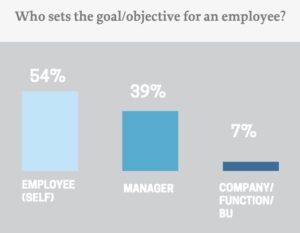
15. MANY GOALS ARE SET MONTHS INTO YEAR
Finding: Even though 60% of companies want goals completed within 2 months, in 54% of companies, goals are not finalized until 3 or more months into the performance management process.
Recommendation: The question that companies need to answer is, “Do goals matter?” If goals truly help to guide and motivate performance (which the science says they do), then we should want high quality goals set before the beginning of the year so they can provide those benefits.
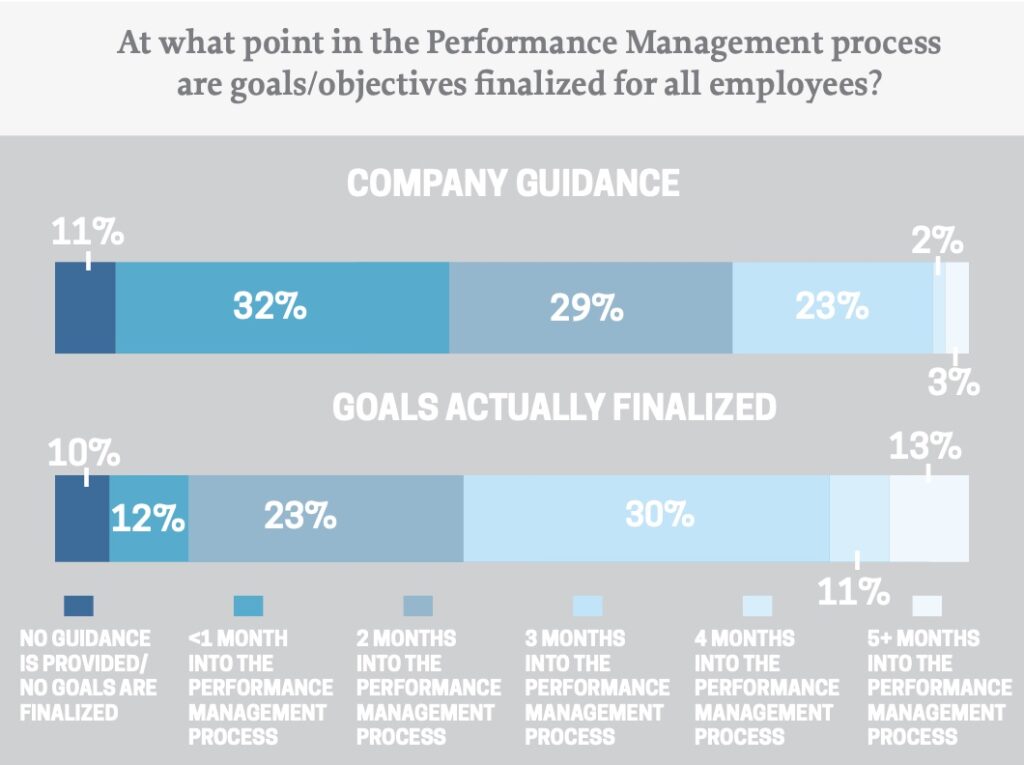
16. NO QUALITY CHECKS ON GOALS BEYOND MANAGERS
Finding: In only 1 out of 10 organizations does someone other than an employee’s manager review the quality their goals.
Recommendation: Goals should be what drives performance in an organization, so having no one independently evaluate the quality of those goals feels like a missed opportunity. We suggest manager-of-manager review and selective HR auditing of goals to help improve goal quality.
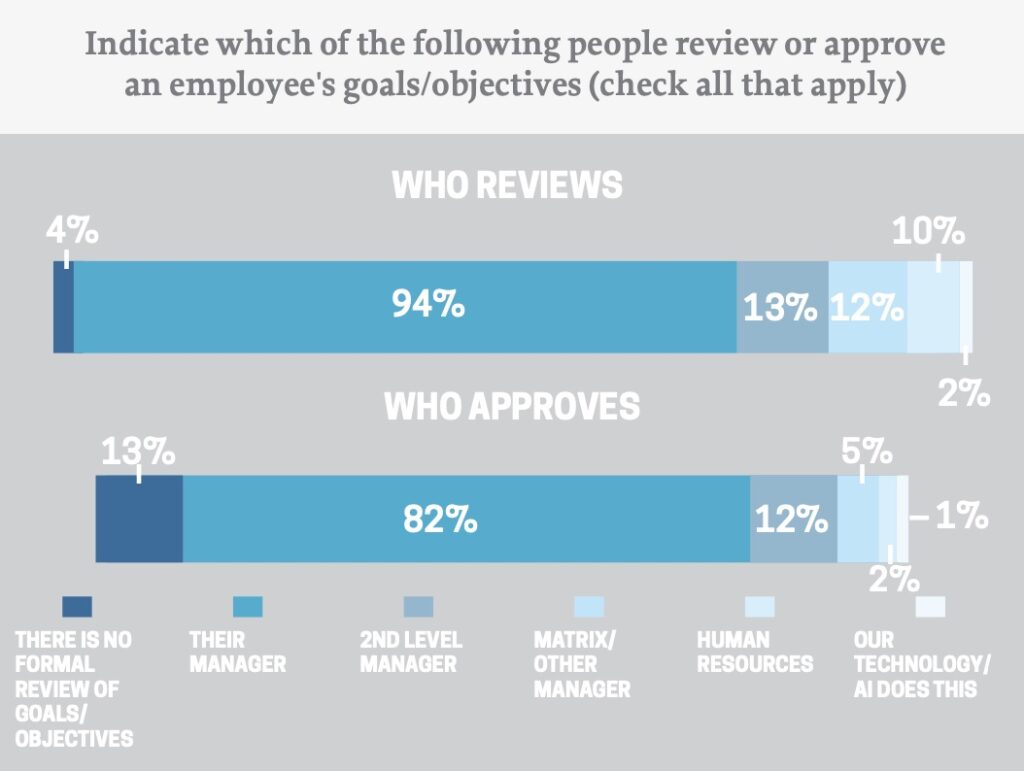
Coaching
17. 3 – 5 ARE RECOMMENDED, BUT MOST GET 1 – 2
Finding: Employees get about half of their company’s recommended coaching conversations each year. 58% of organizations recommend 3 – 5+ conversations but only 30% of employees receive those.
Recommendation: The science is clear that coaching often helps to elevate performance, so missing opportunities to do this undercuts company results. We find the single largest missing ingredient is that managers are not held consequentially accountable for having these conversations.
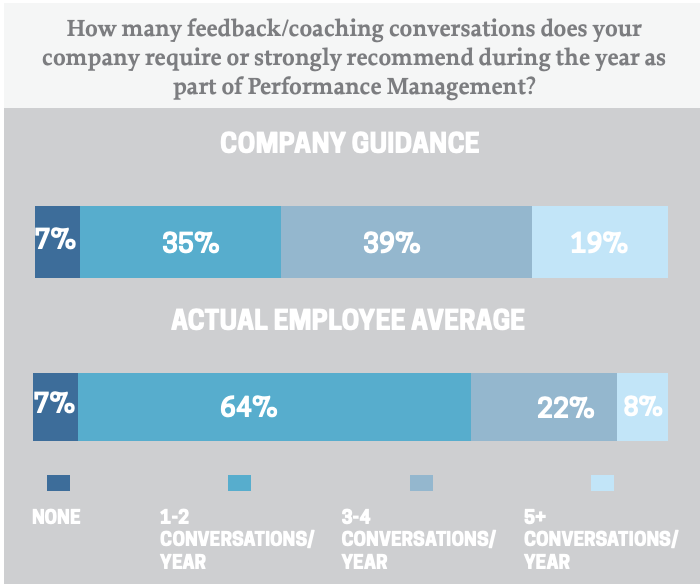
18. FEW COMPANIES CONFIRM COACHING CONVERSATIONS
Finding: In only 12% of companies are coaching conversations required to be entered into their HR system. An additional 17% requires that some conversations be entered.
Recommendation: As with goals, our concern is the quality of the conversation rather than tracking completion. Using completion as a metric, without goals quality checks, is just a valueless administrative exercise.
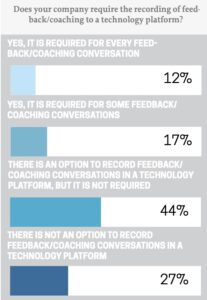
19. TOP-DOWN COACHING DOMINATES
Finding: Formal coaching from one’s manager is hard-wired into 86% of companies’ PM process. Formally structured peer coaching/feedback and upward coaching/feedback are far rarer, used at about 3 in 10 companies.
Recommendation: Given that teaming and managing behaviors can only be accurately evaluated by one’s peers and direct reports, companies should integrate the views of those constituencies into feedback. A 5-question 360s or similarly light tool can balance the value of input with the added complexity of the process.
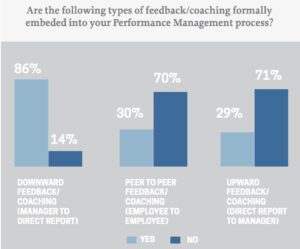
Reviewing
20. FORMAL REVIEWS REMAIN A PERFORMANCE MANAGEMENT STAPLE
Finding: Almost all of our responding companies have a formal review process, with the 14% that don’t largely concentrated in the <2,500 employee segment.
Recommendation: Continuous conversations about goals, performance and behaviors ensure that employees are never surprised in their year- end review. Those continuous conversations don’t replace the need for a formal assessment of performance against goals and behaviors.
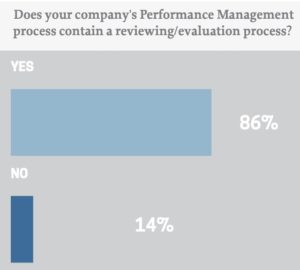
21. ANNUAL AND SEMI-ANNUAL REVIEWS STILL RULE
Finding: The tradition of the annual review continues with 94% of companies formally reviewing performance either once or twice a year. More frequent formal reviews were more prevalent in smaller companies.
Recommendation: Unless a company’s business cycle dictates more frequent formal assessment, a once a year assessment with three quarterly conversations should be sufficient to ensure that employees are clear about their performance and behaviors.
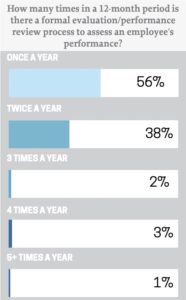
22. LIMITED INPUT ON PERFORMANCE AND BEHAVIORS
Finding Managers assess employees at 95% of companies and employees assess themselves at most of those. Nearly 50% of employees are also asked to assign themselves an overall performance rating. Direct reports and peers have input to results and behaviors at 15% – 20% of companies.
Recommendation: Adding assessments from peers and direct re- ports on behaviors would present a more well-rounded view of an individual’s holistic performance. We believe that self-assessments should be voluntary and it should be made clear that they do not influence the evaluation process.
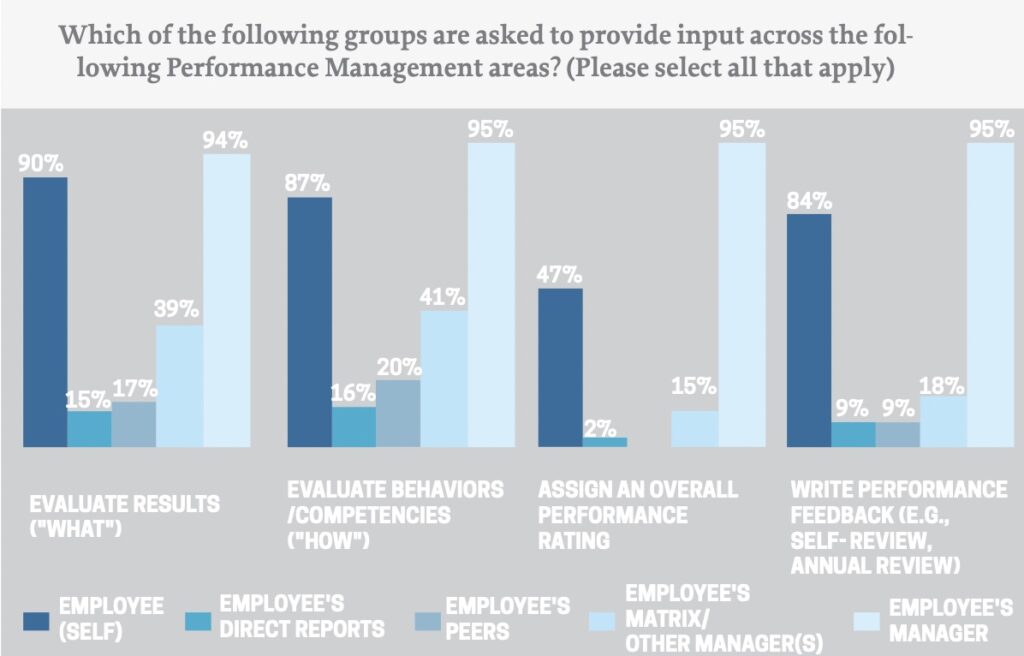
23. PLURALITY BUT NO CLARITY ON BEHAVIOR WEIGHT
Finding: While 37% of companies weight behaviors equally with performance in evaluations, 29% don’t formally evaluate behaviors at all. The average of the highly dispersed data is a 32% weighting for behaviors.
Recommendation: The choice of how much to weight behaviors is one that should come from your company’s talent philosophy. We advise companies to remove “good citizen” behaviors or values from their behavior model and instead measure the few performance-driving behaviors that will advance the strategy. The weighting for behaviors should be large enough that
it motivates employees to display those behaviors.
24. RATINGS DOMINATE; 5 POINT SCALE MOST POPULAR
Finding: 90% of responding companies use ratings. Of the 10% not using ratings, the majority were smaller organizations. The 5-point scale remained the dominant choice, far outpacing the combined users of 3 -point and 4-point scales.
Recommendation: These numbers reinforce that the “no ratings” movement has had limited impact. We reinforce with clients two key points about ratings every week:
1. Ratings are neither inherently good nor inherently evil. There is no evidence suggesting that using ratings as part of
a performance management system has any ill effects (other than those intended).
2. The science is clear that there is no ideal number of points on a rating scale. The only ways to avoid upward bias are to develop in your managers the capability to differentiate performance and/or to force a distribution.
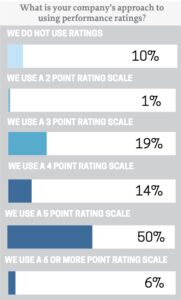
25. RECOMMENDED DISTRIBUTIONS AND NO DISTRIBUTIONS
Finding: The percent of companies with no performance distribution or only a recommended distribution were very similar, with 45% recommending and 39% not recommending. Forced distributions remain rare at 19%.
Recommendation: We rarely find a client that doesn’t complain about over-rating in their performance rating process. The result to this question helps to explain why. With managers likely to overrate their team, having no nor minimal controls on the ratings distribution will ensure this pattern persists unless training and other controls are implemented.
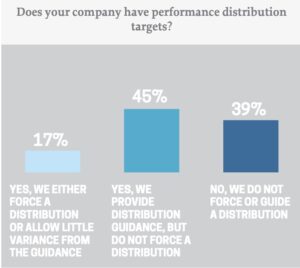
26. RATINGS CALIBRATION
Finding: About half of companies calibrate ratings at some level, providing a check on potentially egregious over-rating
Recommendation: Ratings calibration is a helpful practice when calibration extends up and down the hierarchy, not just by level. We frequently see executives rated highest, directors slightly lower, managers slightly lower, etc.
There’s no reason to assume that executives’ performance, if goals have been properly set, would have any different shaped curve than other levels of management.
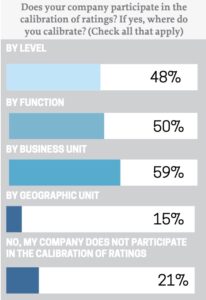
Development/Training
27. DEVELOPMENT PLANNING PAIRED WITH PERFORMANCE MANAGEMENT
Finding: 64% of companies link their development planning process to their performance management process.
Recommendation: We believe that paired or separate, a development planning process needs to be thoughtfully and consistently executed. Our experience globally suggests that development planning is poorly planned and executed in most organizations.
We prefer a separate process for development to ensure that it receives the valuable attention it deserves. We recognize that some managers will see this as less efficient that a combined conversation.
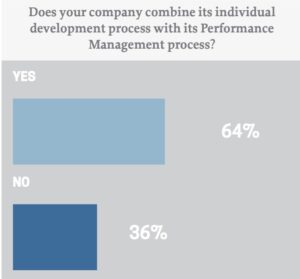
28. TRAINING ON PM RARELY REQUIRED
Finding: Not even 2 in 10 companies requires leaders to be formally trained to set goals, transparently coach or conduct bias-free reviews.
Recommendation: These results help to explain why PM is not well executed in so many companies. Goal setting is a skill that needs to be built and one with the strongest link to higher individual performance.
Transparent coaching has to overcome many psychological hurdles to occur, yet many companies believe that a Powerpoint deck or short video will suffice.
Bias can creep into goal setting and frequently occurs in coaching, and it’s unlikely that merely reading guidance on how to avoid it will have the intended effect.

29. HERE’S WHAT TO IMPROVE
Finding: More than 200 survey participants offered suggestions for how to improve their performance management approach. You’ll see from this word cloud, that “feedback and coaching” was the overwhelmingly dominant theme.
Recommendation: Our experience is that feedback and coaching is the Achilles’ heel of performance management at companies around the globe. We hear a variety of reasons for this including lack of ac- countability, cumbersome processes, untrained managers and bad technology, among others. Our perspective is that the science clearly supports feedback and coaching elevating performance against goals. Therefore, our obligation in HR is to make the process as simple and easy as possible, done at least quarterly, and to have managers be held consequentially accountable for the quality of those conversations.
